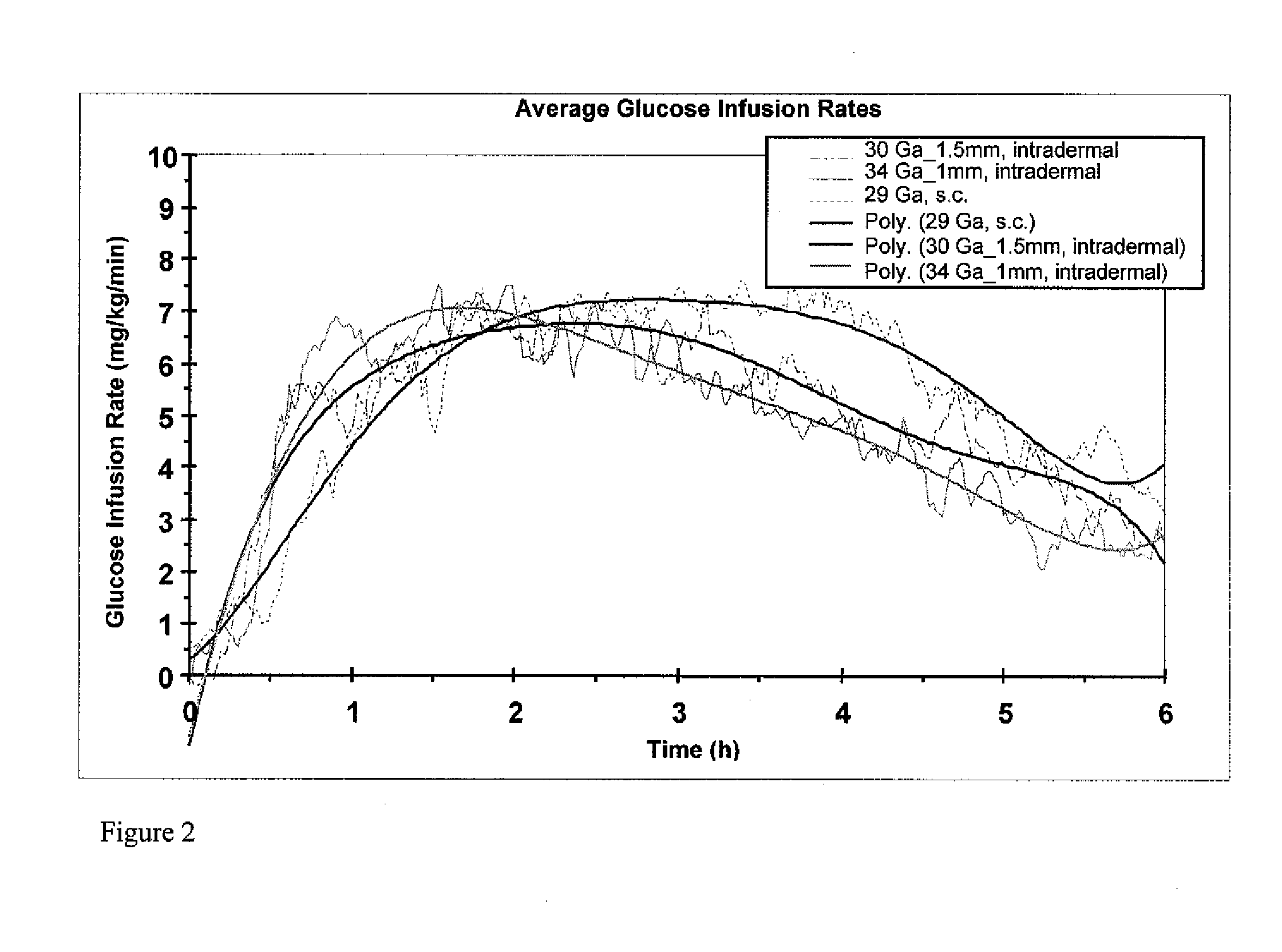Method and device for controlling drug pharmacokinetics
a drug pharmacokinetic and drug technology, applied in the direction of microneedles, infusion needles, medical preparations, etc., can solve the problems of difficult needle placement, variable clinical results, and inability to achieve significant absorption advantages,
- Summary
- Abstract
- Description
- Claims
- Application Information
AI Technical Summary
Benefits of technology
Problems solved by technology
Method used
Image
Examples
example 1
[0065]Pharmacokinetic Fits and Physiological Models for Intradermal Insulin Delivery Profiles from Human Clinical Trials
[0066]In order to investigate the pharmacokinetic and pharmacodynamic effects of human insulin administered intradermally at different depths to the skin, experiments in human volunteers were carried out with two microneedle delivery systems. Fifteen healthy male volunteers (age 28.3±5.4 years, BMI 24.2±2.6 kg / m2 (mean±SD)) received 10 U human insulin via 2 different microneedles of 1.0 and 1.5 mm lengths, and 10 U via standard SC administration. ID microneedle injection was given utilizing a 30 Ga, 1.5 mm microneedle as a rapid bolus in the upper thigh over approximately 10 sec duration; ID microneedle infusion was given using a 34 Ga, 1 mm microneedle infusing into the upper thigh at a rate of 100 microliters / min for a 2 min total duration; SC administration was in the abdomen using a standard 29 Ga, 12.7 mm insulin syringe. Glucostasis was maintained at a contin...
example 2
[0078]Preclinical Diabetic Swine Studies: Administration of insulin at various depths (1.5, 2.0 and 3.0 mm) Volumes and Concentrations
[0079]10 Units of insulin at different concentrations (U40-U400) were administered by bolus single microneedle administration to diabetic swine, and blood samples for insulin level quantitation and blood glucose were withdrawn at serial timepoints. Microneedles were depth limited 31 Ga, single-needle syringe based systems and administration was via manually controlled bolus over several seconds (approx. 5-15). Microneedle delivery depths included 1.5 mm, 2.0 mm, and 3 mm. Data are averages of n=5 or 6. Volumes for 10 IU administration for the different insulin concentrations are U40=250 uL, U50=200 uL, U100=100 uL, U200=50 uL, U400=25 uL. Volume delivery accuracy was insured via the use of calibrated glass microsyringes, and gravimetric quantification of any insulin which was not delivered.
Results:
[0080]Concentration / Volume effects at shallow depth (1...
example 3
Comparison of Delivery of α-Interferon Administered Simultaneously at Two Different ID
[0085]This study was designed to demonstrate achievement of biphasic kinetics based on a specific mechanical design of the delivery device. In comparison to above examples which rely on simultaneous filling of multiple physiological compartments which are spatially related, this study was to investigate the resultant PK from independent filling of two physiological compartments. Interferon alpha (3 million IU in 0.2 mL; 15 million IU / mL concentration) was administered to swine via a single 34 Ga microneedle of either 1 or 3 mm length at a controlled rate of 50 μL / min. This dose was also administered via a standard SC injection from a 30 Ga, ½ inch needle, via a manual bolus (2-15 sec duration). In addition, 0.1 mL (half of the total dose) was delivered simultaneously through 34 Ga microneedles of both 1 and 3 microneedles at 50 μL / min. In this case the total dose remained constant (0.2 mL) but was ...
PUM
 Login to View More
Login to View More Abstract
Description
Claims
Application Information
 Login to View More
Login to View More - R&D
- Intellectual Property
- Life Sciences
- Materials
- Tech Scout
- Unparalleled Data Quality
- Higher Quality Content
- 60% Fewer Hallucinations
Browse by: Latest US Patents, China's latest patents, Technical Efficacy Thesaurus, Application Domain, Technology Topic, Popular Technical Reports.
© 2025 PatSnap. All rights reserved.Legal|Privacy policy|Modern Slavery Act Transparency Statement|Sitemap|About US| Contact US: help@patsnap.com



